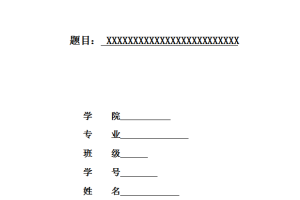基于UG《互换性与技术测量基础》动画模型仿真设计
学生:钟棋
指导老师:姚立影
摘 要:互换性与技术测量是高等院校机械类、仪器仪表类和机电结合类各专业必修的一门重要的技术基础课程,是联系设计系列和工艺系课程的纽带,也是架设在基础课、实践教学课和专业课之间的桥梁。其主要内容是标准化和工程计量学有关部分有机结合,与机械设计、机械制造、质量控制等多方面密切相关,是机械工程技术人员和管理人员必备的基本只是技能。本文详细的叙述了在基于Siemens NXUG6.0的基础上关于《互换性》教学动画模型的分析和设计过程。由于UG软件的操作性强和学习的简单性,即便是零基础的也能快速的完成软件学习过程。因此本文根据UG程序做出了系列螺纹、孔、轴等零件的运动模式,在教学过程中通过这样的动画模型将机构的运动过程形象的表现出来无疑会使学生深刻的了解机械的运动的原理,这种动画模型与传统教学相结合的教学方式有着非常好的前景,或许在未来的几年内这将会成为一种主流的教学方式。
关键字:UG;教学;动画模型
Based on the UG “mechanical design basis” animation design model simulation
Undergraduate:Qi Zhong
Supervisor:Liying Yao
Abstract: interchangeability and technical measurement is colleges machinery, instruments and meters and various kinds of mechanical and electrical combination required an important technical basic course, is the tie that contact design series and GongYiXi course is set up in a bridge between the basic course, practice lesson, and specialized courses. The main content is standardization and metrology related part of the organic combination of engineering, and mechanical design, mechanical manufacturing, quality control is closely related to many aspects, is mechanical engineering and technical personnel and management personnel to the necessary basic skills. This paper described in detail based on Siemens NXUG6.0 on animation \”interchangeability\” teaching model on the basis of the analysis and design process. Because of UG software operationality and simplicity of the study, the even zero basis can quickly complete software learning process. So in this paper, based on UG program has made a series of screw thread, movement model of hole and shaft parts, in the teaching process through the animation model will mechanism motion process image shows clearly makes students understanding the principle of mechanical motion, the animation model combined with the traditional teaching way of teaching has a very good prospect, perhaps in the next few years it will become a mainstream way of teaching.
Key word:UG;Teaching;Animation model
目录
绪论…………………………………………………………………………………………………………………. 1
1 UG10.0软件介绍…………………………………………………………………………………………… 3
1.1 CAD模块……………………………………………………………………………………………. 3
1.2 UG基本界面简介………………………………………………………………………………… 4
2平面连杆及其应用与槽轮的仿真设计…………………………………………………………….. 6
2.1 转动副…………………………………………………………………………………………………. 6
2.1.1 建模…………………………………………………………………………………………… 6
2.1.2 装配…………………………………………………………………………………………… 6
2.1.3运动仿真……………………………………………………………………………………. 6
2.2 移动副…………………………………………………………………………………………………. 7
2.2.1 建模…………………………………………………………………………………………… 7
2.2.2 装配…………………………………………………………………………………………… 7
2.2.3运动仿真……………………………………………………………………………………. 7
2.3平面连杆机构………………………………………………………………………………………. 8
2.3.1平面连杆机构简介……………………………………………………………………… 8
2.3.2 建模…………………………………………………………………………………………… 8
2.3.3装配过程……………………………………………………………………………………. 9
2.3.4运动仿真……………………………………………………………………………………. 9
2.4曲柄滑块机构…………………………………………………………………………………….. 11
2.4.1 建模…………………………………………………………………………………………. 11
2.4.2装配过程………………………………………………………………………………….. 12
2.4.3运动仿真………………………………………………………………………………….. 12
2.5颚式破碎机………………………………………………………………………………………… 13
2.5.1 建模…………………………………………………………………………………………. 13
2.5.2 装配…………………………………………………………………………………………. 15
2.5.3运动仿真………………………………………………………………………………….. 15
2.6 夹紧机构……………………………………………………………………………………………. 16
2.6.1 建模…………………………………………………………………………………………. 16
2.6.2 装配…………………………………………………………………………………………. 17
2.6.3运动仿真………………………………………………………………………………….. 18
2.7牛头刨床……………………………………………………………………………………………. 18
2.7.1 建模…………………………………………………………………………………………. 18
2.7.2 装配…………………………………………………………………………………………. 19
2.7.3运动仿真………………………………………………………………………………….. 20
2.8回转柱塞泵………………………………………………………………………………………… 21
2.8.1 建模…………………………………………………………………………………………. 21
2.8.2 装配…………………………………………………………………………………………. 22
2.8.3运动仿真………………………………………………………………………………….. 22
2.9平面凸轮……………………………………………………………………………………………. 23
2.9.1凸轮简介………………………………………………………………………………….. 23
2.9.2平面凸轮工作原理:………………………………………………………………… 23
2.9.3解析凸轮参数…………………………………………………………………………… 24
2.9.4 建模…………………………………………………………………………………………. 25
2.9.5装配过程………………………………………………………………………………….. 27
2.9.6.. 运动仿真………………………………………………………………………………… 28
2.10空间凸轮………………………………………………………………………………………….. 28
2.10.1建模……………………………………………………………………………………….. 28
2.10.2装配……………………………………………………………………………………….. 29
2.10.3运动仿真………………………………………………………………………………… 30
2.11.. 槽轮……………………………………………………………………………………………….. 30
2.11.1建模……………………………………………………………………………………….. 30
2.11.2装配……………………………………………………………………………………….. 32
2.11.3运动仿真………………………………………………………………………………… 32
2.12电影放映机构…………………………………………………………………………………… 33
2.12.1建模……………………………………………………………………………………….. 33
2.12.2装配……………………………………………………………………………………….. 34
2.12.3运动仿真………………………………………………………………………………… 35
3齿轮系列运动仿真……………………………………………………………………………………….. 37
3.1齿轮简介……………………………………………………………………………………………. 37
3.2外啮合直尺齿轮…………………………………………………………………………………. 42
3.2.1 建模…………………………………………………………………………………………. 42
3.2.2 装配…………………………………………………………………………………………. 42
3.2.3运动仿真………………………………………………………………………………….. 42
3.3 内啮合直尺齿轮…………………………………………………………………………………. 43
3.4平行轴斜齿轮传动……………………………………………………………………………… 44
3.4.1 建模…………………………………………………………………………………………. 44
3.4.2 装配…………………………………………………………………………………………. 45
3.4.3运动仿真………………………………………………………………………………….. 45
3.5齿轮齿条……………………………………………………………………………………………. 46
3.5.1 建模…………………………………………………………………………………………. 46
3.5.2 装配…………………………………………………………………………………………. 46
3.5.3运动仿真………………………………………………………………………………….. 46
3.6行星轮系……………………………………………………………………………………………. 47
3.6.1 建模…………………………………………………………………………………………. 47
3.6.2 装配…………………………………………………………………………………………. 48
3.6.3运动仿真………………………………………………………………………………….. 48
4其他常用机构仿真设计………………………………………………………………………………… 49
4.1 棘轮…………………………………………………………………………………………………… 49
4.1.1 建模…………………………………………………………………………………………. 49
4.1.2 装配…………………………………………………………………………………………. 50
4.1.3运动仿真………………………………………………………………………………….. 50
4.2 拉伸弹簧……………………………………………………………………………………………. 51
4.2.1 弹簧简介………………………………………………………………………………….. 51
4.2.2 建模…………………………………………………………………………………………. 51
4.2.3运动仿真………………………………………………………………………………….. 51
4.3 扭转弹簧……………………………………………………………………………………………. 52
4.3.1 建模…………………………………………………………………………………………. 52
4.3.2 装配…………………………………………………………………………………………. 53
4.3.3运动仿真………………………………………………………………………………….. 53
4.4三角带传动………………………………………………………………………………………… 54
4.4.1 建模…………………………………………………………………………………………. 54
4.4.2 装配…………………………………………………………………………………………. 55
4.4.3运动仿真………………………………………………………………………………….. 55
4.5滑块连轴器………………………………………………………………………………………… 56
4.5.1 建模…………………………………………………………………………………………. 56
4.5.2 装配…………………………………………………………………………………………. 58
4.5.3运动仿真…………………………………………………………………………………. 58
4.6 椭圆仪……………………………………………………………………………………………….. 58
4.6.1 建模…………………………………………………………………………………………. 58
4.6.2 装配…………………………………………………………………………………………. 60
4.6.3运动仿真………………………………………………………………………………….. 60
4.7万向节 …………………………………………………………………………………………….. 61
4.7.1 建模…………………………………………………………………………………………. 61
4.7.2装配…………………………………………………………………………………………. 62
4.7.3运动仿真………………………………………………………………………………….. 62
4.8涡轮蜗杆……………………………………………………………………………………………. 62
4.8.1 建模…………………………………………………………………………………………. 62
4.8.2 装配…………………………………………………………………………………………. 64
4.8.3运动仿真………………………………………………………………………………….. 64
4.9 冲床…………………………………………………………………………………………………… 65
4.9.1 建模…………………………………………………………………………………………. 65
4.9.2 装配…………………………………………………………………………………………. 66
4.9.3 运动仿真………………………………………………………………………………….. 67
4.10机械手冲床………………………………………………………………………………………. 67
4.10.1建模……………………………………………………………………………………….. 67
4.10.2装配……………………………………………………………………………………….. 68
4.10.3运动仿真………………………………………………………………………………… 68
5 总结…………………………………………………………………………………………………………….. 70
参考文献………………………………………………………………………………………………………… 71
致 谢……………………………………………………………………………………………………………. 72





